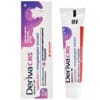No products in the cart.
Tyrosur – antibacterial gel and powder with tyrothricin for treating minor wounds, scratches, and abrasions. Promotes healing and prevents infection.
Great news! The Canada Post strike is over! We’re resuming deliveries to Canada!
Excellente nouvelle ! La grève de Postes Canada est terminée ! Nous reprenons les livraisons vers le Canada !
Great news! The Canada Post strike is over! We’re resuming deliveries to Canada!
Excellente nouvelle ! La grève de Postes Canada est terminée ! Nous reprenons les livraisons vers le Canada !

$34.58
$30.64
Tyrosur – antibacterial gel and powder with tyrothricin for treating minor wounds, scratches, and abrasions. Promotes healing and prevents infection.
Pharmacodynamics. The active substance of the drug Tyrosur – tyrothricin – is a compound of various cyclic and linear polypeptides with antibacterial activity, and is an endotoxin of anaerobic spore-forming bacillus brevis. This compound contains up to 70-80% tyrocidin (basic cyclic decapeptide) and up to 20-30% gramicidin (neutral linear pentadecapeptide).
Active mainly against gram-positive bacteria Staph. aureus MSSA, Staph. aureus MRSA, Staph. haemolyticus, Strep. pyogenes, Strep. viridans, Enterococcus faecalis, Diplococcus pneumoniae, Corynebact. spp., Neisseria meningitides, some strains of Neisseria gonorrhoeae, fungi and Trichomonas, as well as some gram-negative bacteria and some species of fungi, including Candida.
Tyrothricin has a dose-dependent bacteriostatic or bactericidal effect on microorganisms such as Clostridia.
The release of substances such as nitrogen and phosphates from bacterial cells ensures the effectiveness of tyrocidine. Similar to cationic detergents, tyrocidine destroys the osmotic barrier of bacterial cell membranes. Due to its direct action on the bacterial cell wall, the action of the drug Tyrosur is not limited to the inhibition of cell growth or division, it also causes the bactericidal effect of tyrocidine.
In addition, gramicidins form cation channels in the cell membrane of bacteria, which leads to the loss of potassium and, as a result, to a change in the intracellular concentration of cations and cytolysis. A component such as gramicidin further leads to a disruption of phosphorylation processes in the cellular respiratory chain.
Due to the special mechanism of action of tyrothricin, which is not observed in systemic antibiotics, cross-resistance does not develop.
Tyrozur accelerates the wound healing process by cleansing the wound bed and stimulating granulation and epithelialization processes.
Pharmacokinetics. It is not known to what extent tyrothricin can be absorbed systemically. High concentrations have been found in the stratum corneum of the skin (after application to an intact surface) and directly in the wound.
Superficial wounds with minor exudate and the presence of superinfection caused by pathogenic microorganisms sensitive to tyrothricin, such as lacerations, scratches, abrasions.
Powder: 1-2 times a day, sprinkle a thin layer of powder on the affected area of skin and cover with a bandage if necessary.
Gel: apply a thin layer of gel 2-3 times a day to the affected areas of the skin. For small wounds and skin inflammations on open areas of the body, it is usually not necessary to cover them. For large injuries or wet wounds, a protective bandage is recommended, which must be changed after 1-2 days.
The duration of treatment with Tyrosur is determined individually, depending on the course of the disease. If no improvement is observed after a week of use of the drug, it is necessary to review the treatment tactics.
Hypersensitivity to the components of the drug. Contraindicated for intranasal use; there are reports that this method of use may lead to impaired sense of smell.
Skin irritation, allergic reactions including erythema, urticaria, contact dermatitis.
Caution should be exercised when applying the gel to the areas around the eyes as it may cause a burning sensation. Tyrosur gel contains propylene glycol which may cause skin irritation.
Use during pregnancy or breastfeeding
Pregnancy. Data on the effect of the drug on the course of pregnancy are absent. Adequate studies of the effect of tyrothricin on reproductive function in animals have not been conducted. The degree of systemic absorption of tyrothricin after its application to the skin surface is unknown, therefore it should be used with caution during pregnancy. The drug should be used during pregnancy only after assessing the benefit/risk ratio, in small amounts and for a short time.
Breastfeeding. It is not known whether tyrothricin passes into breast milk after external use, therefore, during breastfeeding it should be used with caution, in small amounts and for a short time. During breastfeeding, the drug should not be applied to the breast area. The child should avoid contact with areas of skin where the powder or gel is applied.
Children. If necessary, the drug can be used in children of any age.
The ability to influence the reaction rate when driving vehicles or working with other mechanisms. Does not affect.
Unknown.
No cases of overdose have been reported.
At a temperature not exceeding 25 °C.
Gel. Shelf life after first opening the tube is 3 months.

UApothecary combines medicine search, online ordering, and pharmaceutical consultations. We provide up-to-date information about medications, updating data several times a day. We collaborate with doctors, pharmacists, and medical organizations to offer professional support. We guarantee the quality of medicines and convenient worldwide delivery. Our mission is to make quality medicines accessible to everyone.
This site is protected by reCAPTCHA and the Google
Privacy Policy and
Terms of Service apply.